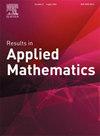计算断头台分区上双色点集的粗略度量
IF 1.4
Q2 MATHEMATICS, APPLIED
引用次数: 0
摘要
红蓝两色平面中一组点的粗细度是衡量这些点混合在一起的程度。它具有吸引人的理论特性,包括与接受良好聚类分区的点集倾向相关联。然而,精确计算它的计算成本很高。本文介绍了使用断头台分区方法计算粗度的概念,并提出了计算这种断头台粗度的高效算法:一种自顶向下的方法和一种动态编程方法,这两种方法都实现了多项式时间和空间复杂度。最后,还提出了一种更快的 O(n2log2n) 多项式时间算法,利用几何数据结构计算被称为两级断头台粗度的简化版测量。这些限制建立了一般断头台粗度的下限,从而可以开发出更高效的计算算法。本文章由计算机程序翻译,如有差异,请以英文原文为准。
Computing the coarseness measure of a bicolored point set over guillotine partitions
The coarseness of a set of points in the plane colored red and blue is a measure of how well the points are mixed together. It has appealing theoretical properties, including a connection to the set of points tendency to accept a good clustering partition. Yet, it is computationally expensive to compute exactly. In this paper, the notion of computing the coarseness using a guillotine partition approach is introduced, and efficient algorithms for computing this guillotine coarseness are presented: a top-down approach and a dynamic programming approach, both of them achieving polynomial time and space complexities. Finally, an even faster polynomial-time algorithm to compute a reduced version of the measurement named two-level guillotine coarseness is presented using geometric data structures for faster computations. These restrictions establish lower bounds for the general guillotine coarseness that allow the development of more efficient algorithms for computing it.
求助全文
通过发布文献求助,成功后即可免费获取论文全文。
去求助
来源期刊

Results in Applied Mathematics
Mathematics-Applied Mathematics
CiteScore
3.20
自引率
10.00%
发文量
50
审稿时长
23 days
 求助内容:
求助内容: 应助结果提醒方式:
应助结果提醒方式:


